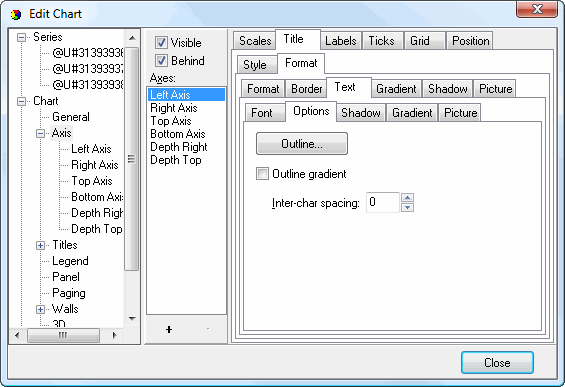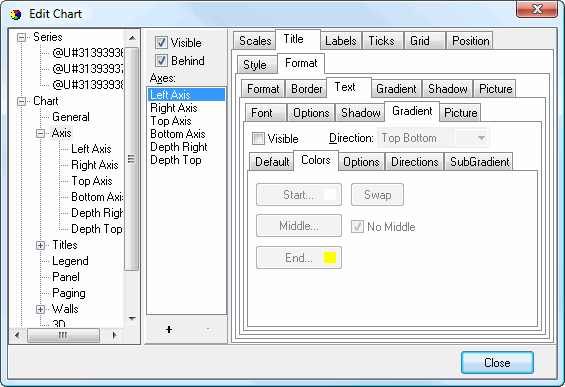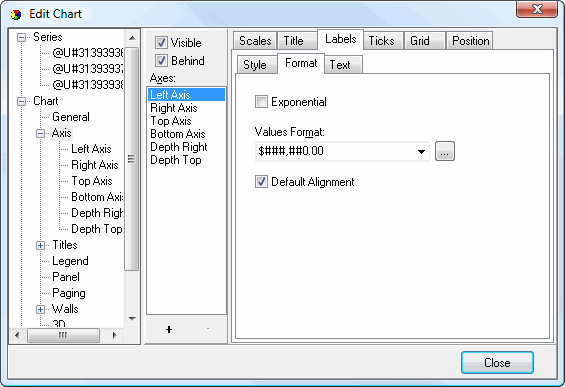The Axis page allows you to format the chart's axes. You can either select the Axis page and select which axis to format from the list on that page or select the specific axis to format in the list at the left. The options are the same for each type of axis.
Two options appear on the Axis page that don't appear if you select a specific axis from the list at the left:
Visible: this option specifies whether the selected axis displays or not.
Behind: this option determines whether the gridlines for the selected axis appear in front of (turned off) or behind (turned on, the default) the items in the chart.

The Options subpage of the Scales subpage has the following options:
Automatic: turn this setting on to automatically determine the scale of the axis.
Visible: this option specifies whether any of the attributes of the axis, such as the labels, title, and gridlines, appear or not.
Inverted: turn this setting on to display the axis from largest to smallest rather than the usual smallest to largest.
Logarithmic: turn this setting on to use a logarithmic scale.
Log Base: this option, which is only available if Logarithmic is turned on, specifies the log base to use.

The Minimum and Maximum subpages of the Scales subpage specify settings for the minimum and maximum values for the axis scale. Each page has the following options:
Auto: turn this setting on to automatically determine the minimum or maximum value.
Change: click this button to change the minimum or maximum value.
Offset: this setting controls the offset for the minimum or maximum value from the appropriate end of the axis.
Round: turn this setting on to round values.

The Increment subpage of the Scales subpage specifies settings for the increment value for the axis scale. It has the following options:
Change: click this button to change the increment value.
Show all labels: turn this option on to display labels for all increment values.

The Style subpage of the Title subpage has the following options:
Title: the text displayed for the axis title.
Angle: the angle at which the title appears.
Size: the amount of space reserved for the title. Use 0 for automatic.
Visible: this option specifies whether the title appears or not.

The Format subpage of the Format subpage of the Title subpage has the following options:
Color: click this button to display a dialog in which you can select the inner color for the shape.
Pattern: click this button to display the Pattern Color Editor dialog.
Transparent: turn this setting on to display a transparent shape. Note that all other settings on this page are ignored if this is turned on.
Transparency: use this setting to control the amount of transparency (in percent) of the shape.

The Border subpage of the Format subpage of the Title subpage has the options which specify the border of the shape in which the title appears. It has the following options:
Bevel: this setting specifies whether the shape appears with a lowered, raised, or no bevel.
Size: this setting, which is only available if Bevel is set to something other than None, specifies the size of the bevel.
Frame: click this button to display the Border Editor dialog for the shape.
Round Frame: turn this setting on to display the shape with a round frame.

The Font subpage of the Text subpage of the Format subpage of the Title subpage has the following options:
Size: select the size of the text.
Color: click this button to control the color of the text.
Style: select the desired style: italic, bold, strikeout, or underline.
Edit: click this button to display the Font dialog, which allows you to change several of the settings on this page at once.
Name: select the name of the font.

The Options subpage of the Text subpage of the Format subpage of the Title subpage has the following settings:
Outline: click this button to display the Border Editor dialog for the outline of the text.
Outline gradient: click this button to display the Gradient Editor dialog for the text outline.
Inter-char spacing: increase the value of this setting to space the characters further apart.

The Shadow subpage of the Text subpage of the Format subpage of the Title subpage has the same options as the Shadow Editor dialog.

The Gradient subpage of the Text subpage of the Format subpage of the Title subpage has the same options as the Gradient Editor dialog.

The Picture subpage of the Text subpage of the Format subpage of the Title subpage has the following options:
Browse: click this button to display a dialog from which you can select the image file to use for the picture.
Filters: brings up the Filters Editor so you can apply various graphic effects to the image.
Transparent: turn this setting on to display a transparent picture.

The Gradient subpage of the Format subpage of the Title subpage controls the gradient settings for the shape in which the title appears. It has the same settings as the Gradient Editor dialog.

The Shadow subpage of the Format subpage of the Title subpage controls the shadow for the shape in which the title appears. It has the same settings as the Shadow Editor dialog.

The Picture subpage of the Format subpage of the Title subpage controls the picture for the title. It has the following options:
Browse: click this button to display a dialog from which you can select the image file to use for the picture.
Filters: brings up the Filters Editor so you can apply various graphic effects to the image.
Transparent: turn this setting on to display a transparent picture.
Style: this controls how the picture is formatted if the image is a different size than the symbol. The choices are:
Stretch: the image is stretched to fit the symbol.
Tile: the image is tiled to fit the symbol.
Center: the image is centered on the symbol.
Custom: turn this option on to specify where the image should be positioned using the Left and Top controls.

The Style subpage of the Labels subpage has the following options:
Visible: this setting specifies whether labels display on the axis.
Multi-line: turn this setting on to split long labels over multiple lines.
Round First: turn this option on to round the first value to 0.
Label On Axis: turning this setting on specifies that a label will appear at the end of the axis.
Alternate: turn this setting on to stagger the labels to minimize overlap.
Size: the amount of space reserved for the labels. Use 0 for automatic.
Angle: the angle at which the labels appear.
Min. Separation %: the minimum separation of values as a percentage of the maximum value.
Style: the type of text to display for values. The choices are Auto (the text is automatically determined), None, Value (displays the values of the axis), Mark (displays point labels as axis labels), and Text (displays category names as axis labels).

The Format subpage of the Labels subpage has the following options:
Exponential: turn this setting on to use exponential values.
Values Format: this specifies the format for values. You can either select one of the commonly used formats from the drop-down list or click the button beside the list to display the Numeric Format dialog.
Default Alignment: turn this setting on to use the default alignment for the specified format.

The Font subpage of the Text subpage of the Labels subpage has the following options:
Size: select the size of the text.
Color: click this button to control the color of the text.
Style: select the desired style: italic, bold, strikeout, or underline.
Edit: click this button to display the Font dialog, which allows you to change several of the settings on this page at once.
Name: select the name of the font.

The Options subpage of the Text subpage of the Labels subpage has the following settings:
Outline: click this button to display the Border Editor dialog for the outline of the text.
Outline gradient: click this button to display the Gradient Editor dialog for the text outline.
Inter-char spacing: increase the value of this setting to space the characters further apart.

The Shadow subpage of the Text subpage of the Labels subpage has the same options as the Shadow Editor dialog.

The Gradient subpage of the Text subpage of the Labels subpage has the same options as the Gradient Editor dialog.

The Picture subpage of the Text subpage of the Labels subpage has the following options:
Browse: click this button to display a dialog from which you can select the image file to use for the picture.
Filters: brings up the Filters Editor so you can apply various graphic effects to the image.
Transparent: turn this setting on to display a transparent picture.

The Ticks subpage has the following options:
Axis: click this button to display the Border Editor dialog for the axis line.
Ticks: click this button to display the Border Editor dialog for the tick lines on the axis.
Len: this option specifies the length of the tick lines.
At Labels Only: turn this setting on to only display tick lines at labels.
Inner: click this button to display the Border Editor dialog for the tick lines inside the axis line.
Len: this option specifies the length of the tick lines inside the axis line.
Minor: click this button to display the Border Editor dialog for the ticks for minor tick lines.
Len: this option specifies the length of the minor tick lines.
Count: this value specifies the number of minor tick lines between major gridlines.

The Grid subpage has the following options:
Grid: click this button to display the Border Editor dialog for the axis gridlines.
Z: this option specifies the offset of the axis gridlines.
Centered: turn this setting on to center gridlines on the values.
Draw every: this setting indicates how frequently gridlines are drawn.
Minor: click this button to display the Border Editor dialog for the ticks for minor gridlines.
Count: this value specifies the number of minor gridlines between major gridlines.

The Position subpage has the following options:
Position %: this setting specifies the position of the axis as a percentage of the total axis size.
Units: this affects the position value. "Percent" means the position value is a percentage of the total chart size while "Pixels" means the value is in pixels.
Start %: the starting position for the axis as a percentage of the total axis size.
End %: the ending position for the axis as a percentage of the total axis size.
Z %: this option specifies the offset of the gridlines from the axis.
Other side: this setting is for internal use only.
Horizontal: this setting is for internal use only.
© Stonefield Software Inc., 2025 • Updated: 06/07/16
Comment or report problem with topic
 Axis Page
Axis Page